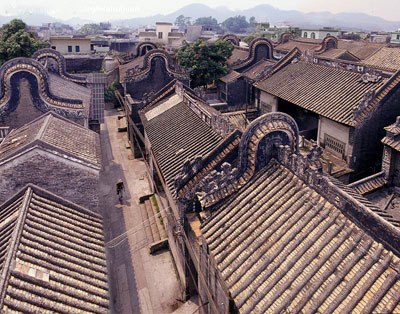
Numerous ancient towns lie scattered around Guangzhou, offering a window into the province's rich cultural heritage and illustrious past. Shawan Ancient Town in Panyu District is one such town. Built over 800 years ago during the Song Dynasty, Shawan has long enjoyed a reputation for being one of the most culturally rich towns in the region. The town boasts over 100 ancient shrines and is lined by beautiful, preserved ancient buildings. Just a subway ride and bus hop away from the city, a visit to Shawan is an idyllic and culturally rewarding way to spend a day away from the city.
Why is Shawan reputed for its culture? For one, many of China's most famous opera singers, dragon and lion dancers, sculptors and musicians originate from Shawan, and the town is lauded as the birthplace of Canton Opera. Shawan has managed to preserve a large number of clay, wood and stone sculptures as well as ancient murals and other Lingnan-style relics.
Even its cuisine is famous throughout the region, especially such specialties as "ginger buried milk" and the mooncake-like pastry "Dongyong Dabing". Another reason is the fact that Shawan puts on colourful parades and traditional events whenever an important festival comes along, transforming the usually quiet town into a buzzing cultural center that pays homage to China's traditional folk and arts.
Main attractions and sights in Shawan Ancient Town
1) Liugeng Ancestral Hall
Liugeng Hall (留耕堂) is located in the northern part of the village and is one of the most famous ancestral halls in the town. Built in 1275 during the Yuan Dynasty, the original building was destroyed only to be rebuilt in the year 1700 over the course of 17 years during the reign of Emperor Kangxi of the Qing Dynasty. The building occupies 3334.25 square meters and is an exemplary example of the ancient science of Fengshui with a hall of worship, a drum tower and east-west verandas.
2) Wenfeng Pagoda
Wenfeng Pagoda (文峰塔) can be found in the Guan Alley of the northern village. Built in 1721, this site was once the highlight of the ancient attracting superstitious academics and children from near and far who flocked here in droves to worship the statues inside. The pagoda itself has three stories and six corners.
3) He Binglin Memorial Hall (Yanqing Hall) 何炳林院士纪念馆(衍庆堂)
This memorial hall on Anning Middle Street, which was built during the Jiaqing years of the Qing Dynasty, was originally dedicated to Ho Chi-Ming and his ancestors. However, that honor later went to He Binglin, a 24th generation grandchild of the Shawan He minority, who was a renowned chemist and educator and the first person in China to successfully carry out a test explosion of an atomic bomb. He is acknowledged as the pioneer who kick-started China's ion resin industry and is nicknamed "the father of ion exchange resin".

Copyright ©1999-2011 Chinanews.com. All rights reserved.
Reproduction in whole or in part without permission is prohibited.